As a homeowner, you strive for a comfortable and efficient living environment that keeps your energy bills in check while contributing to a sustainable future. Energy efficiency is the key to achieving these objectives.
Simply put, it refers to the ability of a home or building to use less energy and provide the same level of performance, if not better. Improving energy efficiency in residential buildings not only reduces the strain on the environment but also brings numerous benefits for homeowners.
A. Definition of Energy Efficiency: Energy efficiency is the concept of utilizing energy in a way that minimizes waste and maximizes the output achieved. When it comes to homes, it means adopting various measures and techniques to optimize energy consumption without compromising on comfort, convenience, or functionality.
B. Benefits of Implementing Energy-Efficient Measures: Implementing energy-efficient measures in your home can yield several advantages. Not only does it lower your utility bills by reducing energy consumption, but it also improves the overall comfort and livability of your space.
Additionally, energy efficiency helps reduce greenhouse gas emissions, lessens your carbon footprint, and contributes to a sustainable future by conserving valuable resources.
If you’re looking to enhance your home’s energy efficiency, this comprehensive guide presents 15 essential improvements that can make a significant difference.
From simple do-it-yourself tasks to professional upgrades, you’ll discover a range of effective strategies to transform your home into an energy-efficient haven. Get ready to improve your comfort, save money, and take a step towards a greener world!
Table of Contents
Insulation
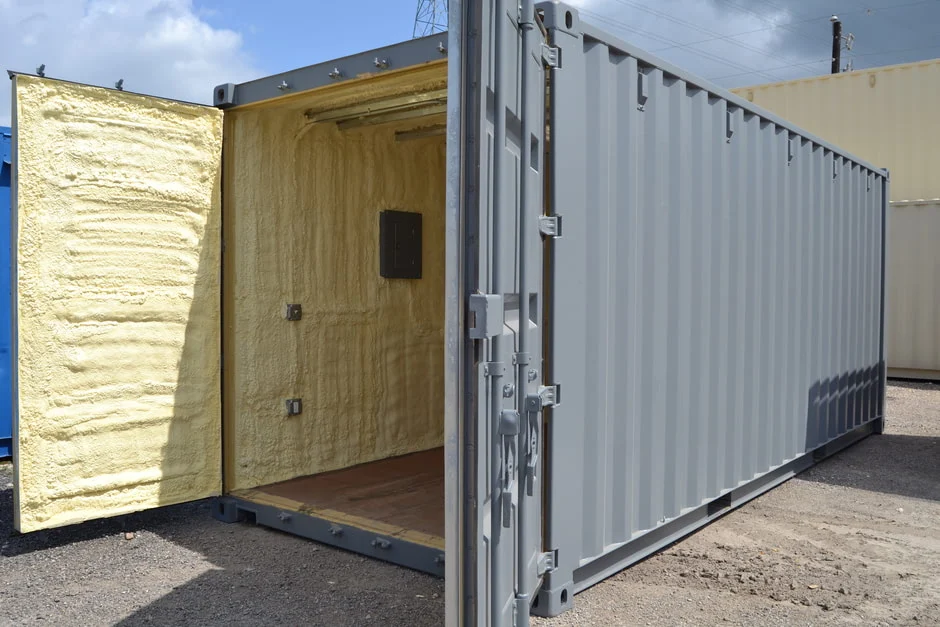
Proper insulation is a crucial factor in improving the energy efficiency of your home. By keeping the outside air from seeping in and the conditioned air from escaping, insulation helps to maintain a comfortable indoor temperature and reduce the need for excessive heating or cooling.
Not only does this lead to significant energy savings, but it also enhances the overall comfort of your living space.
Types of Insulation Materials
There are several insulation materials available, each with its own unique properties and benefits. Fiberglass insulation, for example, is made from fine glass fibers and is commonly used in both residential and commercial structures. It is known for its excellent thermal resistance and affordability.
Cellulose insulation, on the other hand, is made from recycled paper treated with fire-retardant chemicals. It offers a high resistance to airflow, making it an efficient choice for insulating attics and walls.
Spray foam insulation is a popular option for sealing gaps, cracks, and cavities. It expands to fill the smallest of spaces, creating an airtight barrier. This type of insulation also provides exceptional soundproofing qualities.
Insulation Installation Techniques and Best Practices
When it comes to installing insulation, there are several techniques and best practices to ensure maximum effectiveness. Hiring a professional insulation contractor is recommended for proper installation, as they have the knowledge and expertise to handle the job efficiently.
- Properly sealing air leaks before insulation installation is vital for optimal energy efficiency. This includes sealing gaps around windows, doors, and electrical outlets.
- Insulation should be installed in the correct thickness and density to achieve the desired R-value, which measures thermal resistance.
- Ensuring insulation is installed without any gaps or compressions is essential for its effectiveness. Any voids in the insulation can compromise its ability to provide proper thermal insulation.
- Installing insulation in attics, crawl spaces, and basements can significantly reduce heat loss and energy consumption.
By investing in quality insulation materials and following proper installation techniques, you can create a well-insulated home that not only saves energy but also enhances your comfort and reduces utility costs.
| Image | Product Title | Features | Price |
|---|---|---|---|
 | Buy on Amazon | ||
 | Buy on Amazon | ||
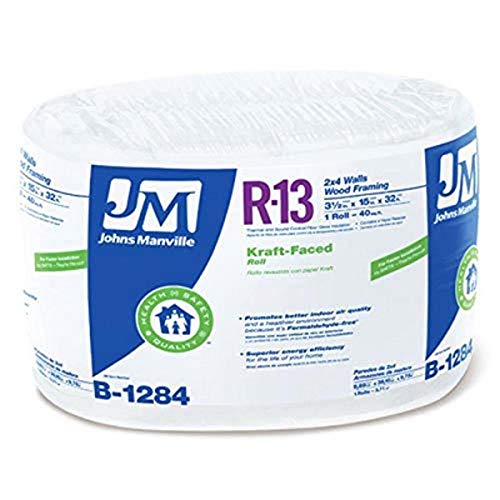 | Buy on Amazon |
Windows and Doors
Improving the energy efficiency of your windows and doors is crucial in reducing heat loss or gain in your home. By making the right choices, you can create a more comfortable living environment while also saving on energy costs.
A. Significance of Energy-efficient Windows and Doors in Reducing Heat Loss/Gain
Windows and doors are often the weakest points of thermal protection in a house. Traditional single-pane windows and poorly insulated doors can let in drafts and allow heat to escape during the winter, and let in excessive heat during the summer.
By upgrading to energy-efficient windows and doors, you can reduce the amount of heat transfer, making your home more comfortable throughout the year.
Read More on Why Container Shortage Compromise Global Logistics And Trade
B. Overview of Different Glazing Options (e.g., double-glazed, low-emissivity)
One popular option for energy-efficient windows is double glazing. Double-glazed windows consist of two panes of glass separated by an insulating pocket of air or gas.
This design provides better insulation and reduces heat transfer. Low-emissivity (Low-E) coatings are another popular choice. These coatings reflect heat back into the room during winter and block excessive heat from entering during summer, improving the overall energy efficiency of the window.
C. Weatherstripping and Sealing Techniques for Doors
Properly sealing your doors is a crucial step in improving energy efficiency. Weatherstripping can help prevent drafts and air leakage around the edges of doors.
There are various types of weatherstripping materials available, such as adhesive-backed foam tape or door sweeps. Sealant and caulking can also be used to fill any gaps or cracks around the frame or threshold of the door, further reducing air leakage.
Read More on Best Poolside Container Plants – Stunning Pool Area Choices
Lighting
In this section, we will explore the importance of energy-efficient lighting in improving home energy efficiency. By making smart choices with your lighting, you can not only reduce your energy consumption but also save money on your utility bills.
A. Introduction to Energy-efficient Lighting Options
Energy-efficient lighting options, such as LED (Light-Emitting Diode) and CFL (Compact Fluorescent Lamp), are revolutionizing the way we illuminate our homes.
These alternatives to traditional incandescent bulbs offer numerous benefits, including higher energy efficiency, longer lifespan, and improved environmental impact.
B. Advantages of Using Energy-efficient Bulbs
When you switch to energy-efficient bulbs, you can enjoy significant advantages in terms of both lifespan and cost savings.
LED bulbs, for example, have a lifespan of up to 25,000 hours, compared to just 1,200 hours for incandescent bulbs. This means you’ll spend less time and money replacing bulbs and more time enjoying well-lit spaces in your home.
Additionally, energy-efficient bulbs consume significantly less electricity, resulting in substantial cost savings over their lifetime. Not only will you see a reduction in your monthly utility bills, but you’ll also contribute to a greener and more sustainable environment.
Read More on Best 15 Home Energy Efficiency Improvements: 2023
C. Tips on Optimizing Lighting in Different Areas of the Home
Optimizing lighting in different areas of your home is crucial for achieving energy efficiency. Here are some tips and best practices to help you make the most of your lighting:
- Use task lighting in specific areas, such as reading nooks or workspaces, to provide focused illumination where needed.
- Utilize natural light whenever possible by opening curtains or blinds during the day, reducing the need for artificial lighting.
- Install dimmer switches, which allow you to adjust the brightness of your lights according to the time of day or the activity being performed.
- Consider using motion sensor lights in areas like hallways, closets, or outdoor spaces, as they automatically turn on and off based on movement, saving energy when not in use.
- Regularly clean light fixtures and replace dusty or dirty bulbs, as dirt and grime can reduce the brightness and efficiency of your lighting.
By implementing these lighting optimization techniques, you can create a well-lit, energy-efficient home that not only enhances your comfort but also lowers your energy consumption.
Read More on 2023 Outdoor Solar Garden Lights: Ultimate Costs, Pros & Cons
Heating, Ventilation, and Air Conditioning (HVAC) Systems
When it comes to home energy efficiency, one area that shouldn’t be overlooked is the Heating, Ventilation, and Air Conditioning (HVAC) systems. These systems play a crucial role in managing heating and cooling, and optimizing them can lead to significant energy savings.
A. Importance of Energy-efficient HVAC Systems in Managing Heating and Cooling
An energy-efficient HVAC system ensures that your home stays comfortable all year round while consuming less energy. These systems are designed to minimize energy waste by using advanced technologies and optimized components.
- Energy-efficient HVAC systems utilize variable-speed motors, which adjust the fan speed to meet the current heating or cooling demands of your home. This means that the system doesn’t need to run at full speed constantly, reducing energy usage.
- Proper insulation and sealing of ductwork can also improve the efficiency of HVAC systems. By preventing air leakage, your HVAC system won’t have to work as hard to maintain the desired temperature.
- Additionally, energy-efficient HVAC systems often come with smart thermostats that allow you to schedule temperature adjustments according to your lifestyle. This helps avoid unnecessary cooling or heating when you’re not at home, further reducing energy consumption.
B. Upgrading or Optimizing HVAC Systems for Better Energy Performance
If your current HVAC system is outdated or inefficient, upgrading or optimizing it can make a significant difference in your home’s energy efficiency. Here are some improvements you can consider:
- Replace old, energy-guzzling HVAC units with newer models that have higher energy efficiency ratings. Look for units with ENERGY STAR certification for guaranteed energy savings.
- Consider installing a zoned HVAC system, which allows you to control the temperature of different areas or rooms independently. This way, you can avoid cooling or heating unused spaces, thus reducing energy waste.
- Ensure proper sizing of your HVAC system. A system that is too large or too small for your home can result in energy inefficiencies and discomfort. Consulting with a professional HVAC contractor can help you determine the right size for your specific needs.
Read More on How To Do Solar System Sizing For Your Home
C. Regular Maintenance and Filter Replacement to Enhance Efficiency
Maintaining your HVAC system is crucial to its long-term efficiency and performance. Regular maintenance and filter replacement can significantly enhance its energy efficiency. Here’s what you should do:
- Schedule professional HVAC maintenance at least once a year. A trained technician will inspect, clean, and tune up your system to ensure optimal efficiency.
- Regularly clean or replace the air filters. Clogged filters restrict airflow, making your HVAC system work harder and consume more energy. Check the filters monthly and replace them as needed.
- Keep the outdoor unit clean and free from debris, such as leaves or twigs. This allows for better airflow, preventing unnecessary strain on your HVAC system.
By focusing on your HVAC systems and implementing these energy-saving improvements, you can reduce your energy consumption, lower utility bills, and contribute to a more sustainable future for your home.
- 62 oz. dehumidifier with auto shut off and sleep mode to maximize efficiency.
- Suitable for a 950 square foot space, perfect for bedroom, basement, home or RV.
- Ultra-quiet operates at under 39dB- Quiet operation.
- Lightweight and portable, easy to move and store.
- 24 hour auto shut off timer and continuous drainage system.
- Easy-to-use control panel and LCD digital display.
- Filter can be easily cleaned to reduce bacteria build-up.
- Removable tank for convenient emptying and water-level indicator for easy monitoring.
- Empty water-tank warning for convenience and safety.
- Energy efficient to save on your electricity costs.
15 Examples of Energy Efficient Homes From Across the World
1. WaterShed Maryland House
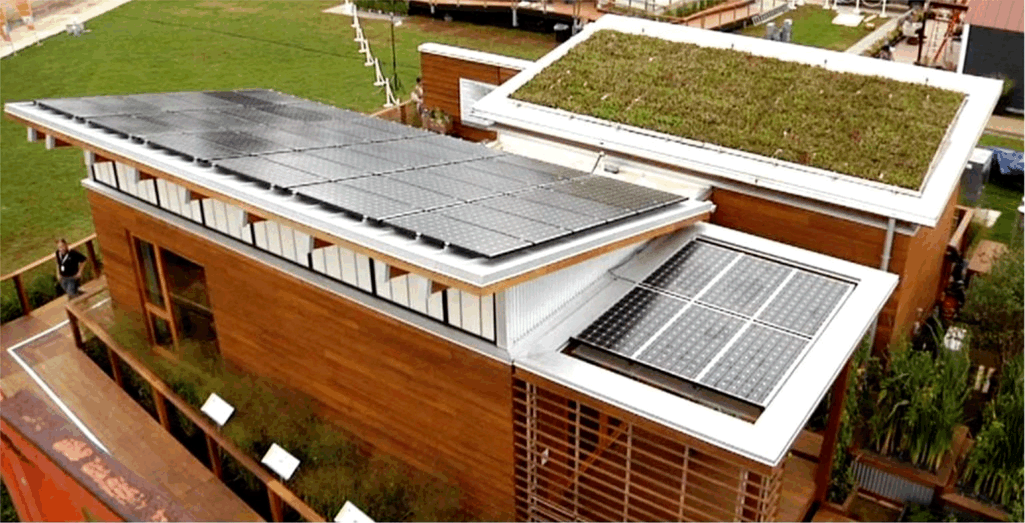
The University of Maryland’s purpose was to design an energy-efficient house that could stand as a model for future homes.
The wastewater from a washing machine, dishwasher, and shower will recycle through filtering. Moreover, capturing and filtering rainwater takes place to avoid any water wastage.
The waterfall, which also serves as a liquid desiccant and humidity control system, looks excellent while ensuring the right moisture in your home. The excess electricity from the solar panels is on standby for later use.
In addition, The house has a state-of-the-art system that monitors and adjusts several parameters to maintain optimal comfort: temperature, lighting, and humidity level.
2. The High Sierra Cabin Home
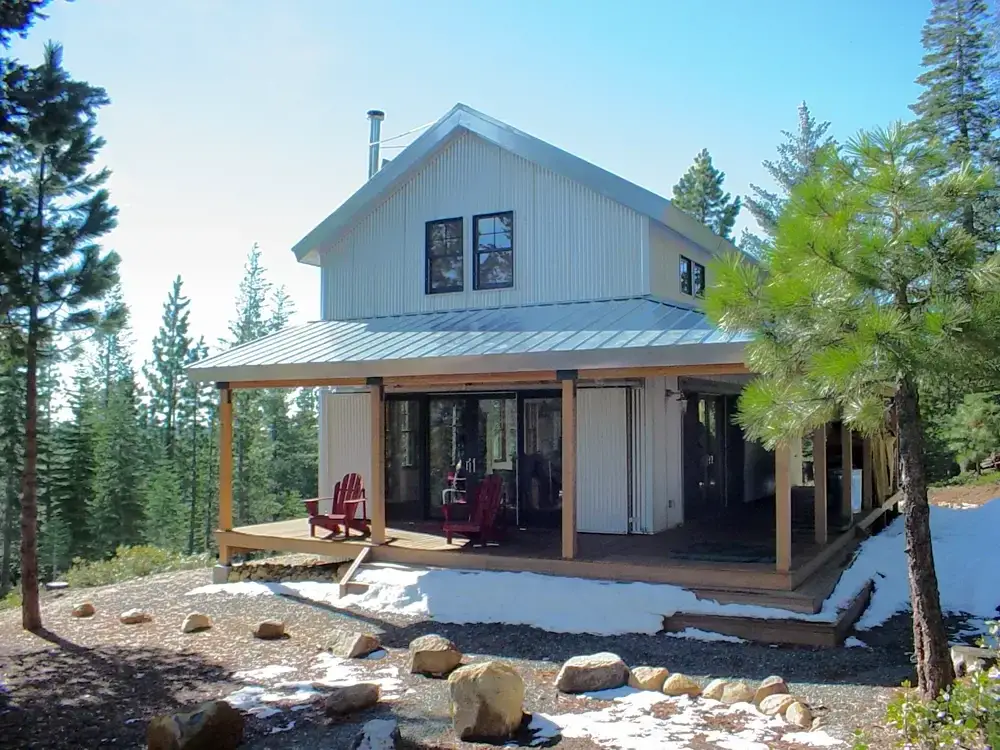
This home is located in the Sierra Nevada mountains and measures 1015 square feet. The walls consist of structural insulation panels, making them energy efficient.
The costs are almost similar to building with wood, so there is no financial reason not to choose SIPs. They are shipped and prefabricated to be assembled on-site.
SIPs are an excellent option for areas with heavy snowfall and strong winds, tightly insulating the interior of homes and thus reducing heating costs.
The house has large windows and skylights, therefore, allowing lots of natural light. You can also find photovoltaic panels on metal roofs.
The S-5 bracketing system, combined with a seam metal roof, would have been an ideal configuration for mounting PV solar panels. In addition to the panels, a battery storage system stores any excess electricity and use it at night.
3. The Jungle Shelter Homes

This house has 1 bedroom, is 384 sq. ft., and costs slightly higher than$1,200. The exterior walls of this home are studs with spray foam insulation to provide a tropical-proof structure, while they make the roof with thick rigid foam board insulation (about six inches15 cm).
The house also boasts a rainwater harvesting system that you can use to water the garden and flush toilets. In addition, you can install solar panels on an external structure at your discretion.
Read More on Environmental Impact Of Solar Energy
4. DesertSol Las Vegas House
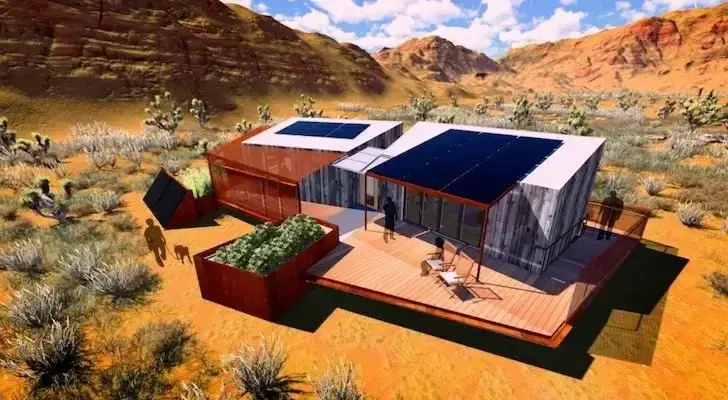
The University of Nevada, Las Vegas, constructed an ultra-efficient house that relies on solar power and conserves water. It’s called DesertSol because it can easily withstand the harsh conditions of a desert climate.
The 30-panel PV (solar) system generates enough electricity for the house’s cooling, heating, lighting, and common household appliances.
The hydronic floor heating system uses water for heat transfer since it is more efficient than air. You can collect rainwater and humidity to be part of the cooling and irrigation systems. The house was given a LEED Platinum certification for its green building practices.
5. The Mountain Shelter Homes
This house is situated in the heart of the mountain and covers 688 sq. ft. It has no garage, but it does have only 1 bathroom.
Energy-efficient houses often use solar panels, but you must clear the snow from your roof daily for them to work. This house’s insulation is state-of-the-art and makes it far more energy efficient than most others on the market.
In addition, the roof of the house is made from 2×10 rafters with a 9-inch thick layer of foam insulation. The walls are also covered by highly efficient foam.
6. Y Container China House
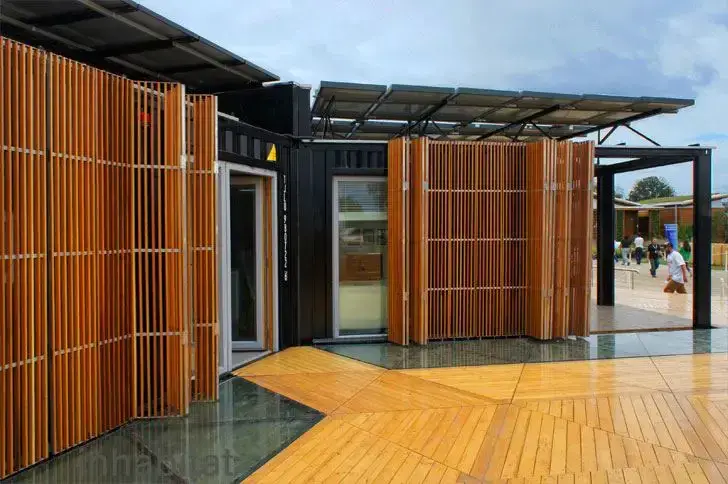
This is a Y-shaped house made from 6 shipping containers, which gave it its name: the Y container. This design incorporates landscaping that lets residents view various yard sections’ landscapes while using solar energy to heat hot water and floors.
Phase-change materials and vacuum insulation block heat transfer. The house has a natural ventilation tunnel that ensures fresh air without increasing operating appliance costs. The Tongji University team designed this building, which took part in the 2011 Solar Decathlon.
Read More on Luxury Container Hotels – Offering Unique Experiences
7. Ikaros House
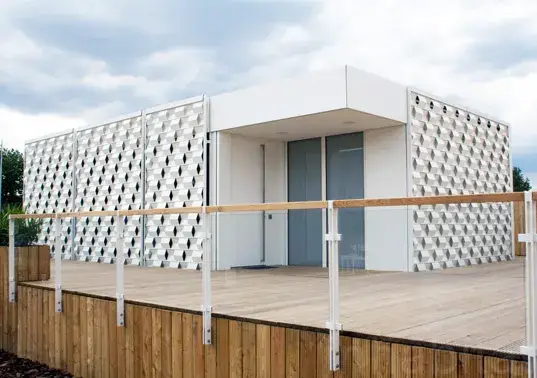
This is the IKAROS house. It was specially built for a Solar Decathlon competition, in which countries or American states compete to build the most energy-efficient home.
It costs more than $300,000 to build and will resell renewable energy worth approximately $5000 per year. This excess heat can be used to warm the house in winter. Vacuum insulation panels provide tight insulation and help keep cooling costs down.
The heat that exits from these units is piped into a tank of water, which heats up enough for people to take hot showers all year round!
8. FLeX House
The FLeX house is a design used to reduce energy costs in areas that face months of extreme heat. The architects behind this concept claim that a family with moderate incomes could live comfortably under such conditions.
The building is shaded by the cypress louvers installed on its roof and walls. In addition, the entire north wall opens up to cool interior spaces.
The house’s solar panels, heat pump, and mini-split system ensure that the right amount of heating and cooling is provided.22 panels, every 5 kilowatts in size, are installed together with 11 micro-inverters.
The amazing software that monitors and diagnoses malfunctions along the way is appreciated by anyone who has worked with such systems. The FLeX’s low cost and small footprint make it a space-efficient way to provide housing.
Read More on Ultimate Guide To Solar Panels: Everything You Need to Know
9. LISI House

The design of this house won first place in the 2013 Solar Decathlon. Four rooftop photovoltaic modules generate more energy than the home uses each day.
An ERV unit, a dehumidifier, and a heat exchanger control the temperature inside. Also common to most spaces is an open floor plan that allows for natural light, ensuring proper ventilation of the building.
The vertical gardens allow residents to grow their fruits and vegetables. The exterior movable curtains keep the temperature inside at a pleasant level.
10. The AIR House in the Czech Republic

This design embraces a small living area with ample ventilation to promote fresh air flow into and out of the house.
The acronym A.I.R stands for affordable, innovative, and recyclable, and it was designed to compete in the 2013 Solar Decathlon competition in Irvine, California.
The exterior is made of wood for the most part, including its thermal insulation and load-bearing structure.
Artificial lighting was installed and programmed to adjust to people’s circadian rhythms. The system mimics natural conditions as closely as possible.
A solar wooden canopy provides electricity and protection from sun rays. If staying green is essential to you, an electric bicycle can be powered by a charging station. In addition, the entire house is run on solar energy, including hot water.
Read More on Are Container Homes Legal in Miami? Find Out the Facts!
11. Canopy House (Modular House Tidewater Virginia)
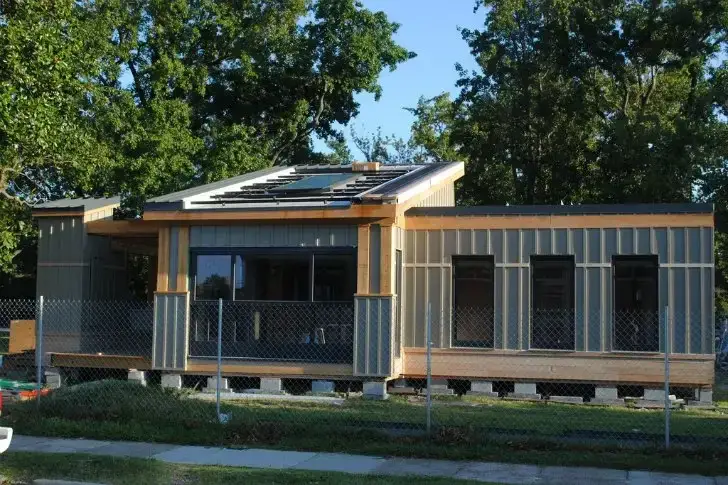
The Canopy House, designed by Hampton University and Old Dominion University, sits atop an old water tower. This property’s layout and architecture make it easier for disabled persons to move around.
The interior and exterior spaces of the home are connected via a folding glass door system, while radiant floor heating is used to keep things cozy.
The surplus energy generated by solar thermal panels helps keep water hot and safe for bathing! The HVAC system’s mini-split design makes it both affordable and energy efficient.
The energy management system is controlled via a tablet application. It’s interactive and teaches users how to make household electricity consumption decisions.
12. DALE House
The house was dubbed DALE for Dynamic Augmented Living Environment. It’s made of two distinct “modules,” or areas, for living and sleeping. When opened, these modules create extra space for the outdoors by sliding on a rail system.
The traditional exterior layer is replaced by waterproof vinyl. This allows all the house’s electricity needs to be covered by 28 photovoltaic panels.
Consequently, high-tech solar water heating technology brings hot water to the house. The system uses software that collects information about energy production, consumption, and indoor temperatures to maintain efficient operation.
13. Stanford CORE House
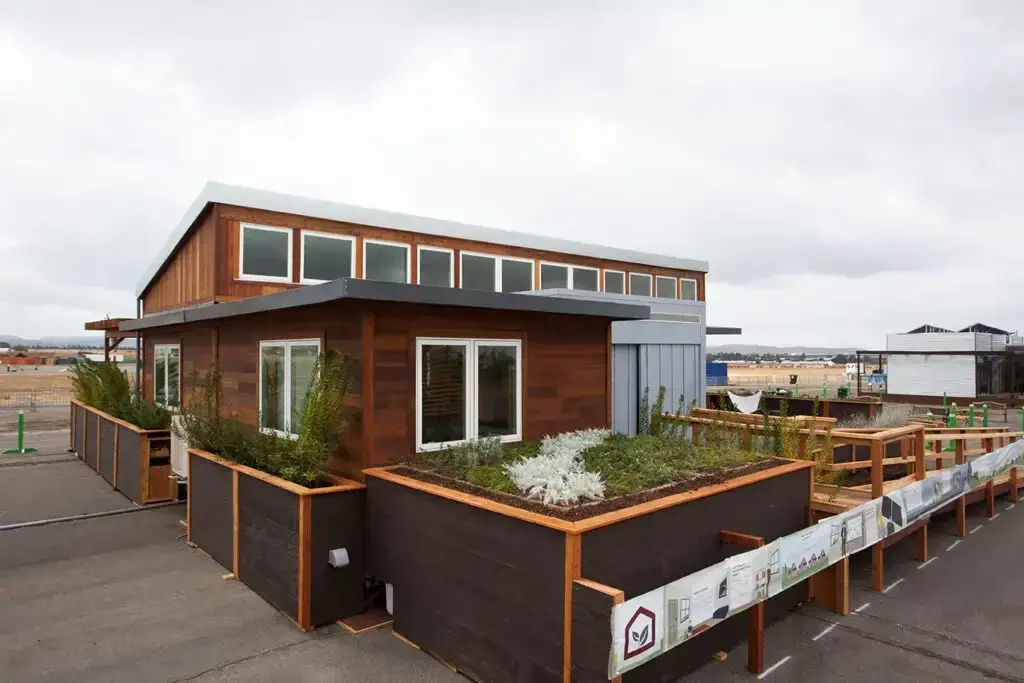
Stanford University designed this house, which is made up of a central module that can be added to as needed.
The CORE system, a pre-fabricated core that houses the kitchen, bathroom, and laundry room, along with their respective electrical and plumbing systems, is used to unite all the modules of this home.
Salvaged wood from old houses was used for the exterior redwood siding to keep heat transfer at a minimum and reduce costs. The interior hardwood floors were also made of salvaged lumber.
Read More on Shipping Container Homes In Arizona: Stylish And Affordable
14. Delta T-90 house
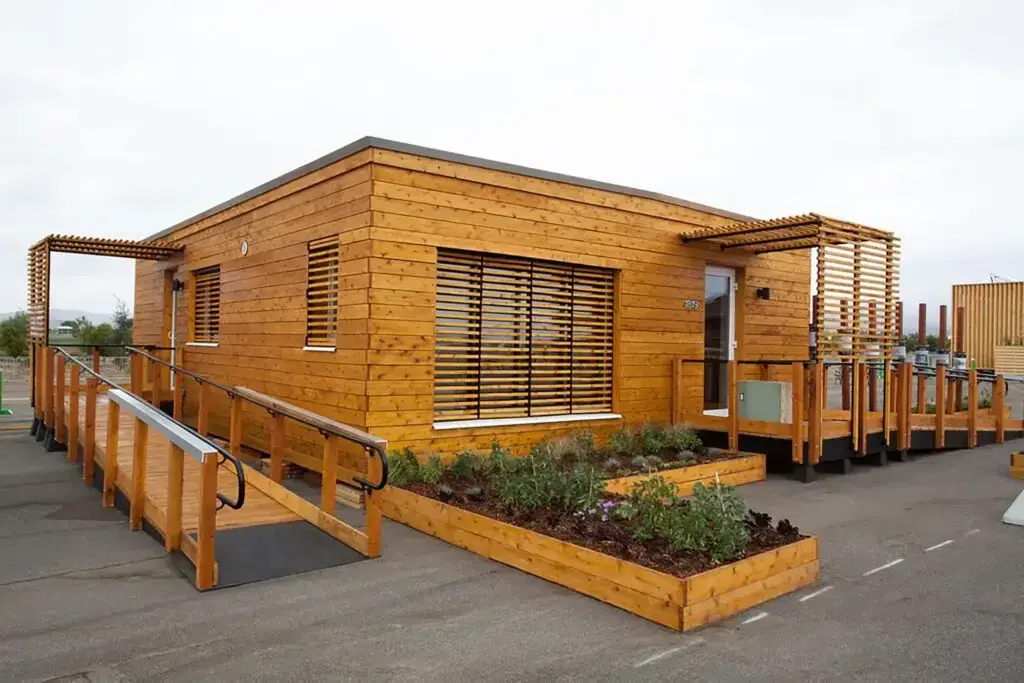
The Delta T-90 showed that high-performance houses can be sold at moderate prices. The Vermont producer of this home claims that people whose income is 20% below the state’s average can afford it and may well be right.
They prioritized insulation and chose high ceilings and windows to let in light.
Additionally, the heat pump HVAC system uses less energy than other systems and works without ducts or overt elements, so minimal space is lost compared with what you would find in a traditional HVAC.
15. Radiant House
The Radiant House, designed by Santa Clara University students, is an excellent example of how one can be energy efficient without a high price tag.
PV panels are integrated into the roof structure, with a passive cooling system placed below them.
Large windows allow a lot of light, and the dwelling has access to free hot water from a tank filled with organic phase-change materials.
Renewable Energy Sources
Renewable energy sources play a crucial role in achieving sustainable energy solutions and reducing carbon footprints.
By harnessing the power of natural resources, homeowners can contribute to a greener environment while also enjoying long-term savings. Let’s explore some of the most popular renewable energy sources for homes:
A. Overview of Solar Panels and Their Benefits in Generating Clean Energy
Solar panels, also known as photovoltaic (PV) systems, convert sunlight into electricity. Installing solar panels on your roof allows you to generate clean, renewable energy and reduce your dependence on fossil fuels. Some benefits of solar panels include:
- Cost savings: By producing your own electricity, you can significantly reduce your monthly energy bills.
- Environmental impact: Solar energy is clean, emits no greenhouse gases, and reduces your carbon footprint.
- Energy independence: With solar panels, you become less reliant on the grid, providing energy security during power outages.
- Long-term investment: Solar panels have a long lifespan, typically lasting 25 to 30 years, making them a sound investment for homeowners.
B. Integration of Wind Turbines to Harness Renewable Energy for Homes
Wind turbines are another form of renewable energy generation that can be integrated into residential properties. By capturing wind energy, homeowners can benefit from:
- Constant energy production: Wind turbines can generate electricity even with lower wind speeds, ensuring a steady power supply.
- Reduction of electricity bills: By producing your own wind energy, you can offset a portion or even the entirety of your electricity costs.
- Low maintenance: Modern wind turbines are designed to be durable and require minimal maintenance, providing hassle-free energy generation.
- Contribution to a sustainable future: Wind energy is clean and renewable, helping to combat climate change and reduce reliance on non-renewable energy sources.
C. Considerations and Costs Associated with Installing Renewable Energy Systems
When considering installing renewable energy systems, it’s essential to take into account various factors, including:
- Initial investment: The cost of purchasing and installing solar panels or wind turbines varies depending on the size and complexity of the system.
- Available space: Roof orientation and available land area are crucial in determining the suitability and capacity of renewable energy systems.
- Incentives and grants: Government incentives and grants may be available to help offset the upfront costs of installing renewable energy systems, making them more affordable for homeowners.
- Payback period: Assessing the payback period and return on investment will help determine the long-term financial feasibility of installing renewable energy systems.
By carefully considering these aspects and consulting with renewable energy professionals, homeowners can make informed decisions about integrating solar panels or wind turbines into their properties, enhancing both energy efficiency and sustainability.
Read More on Shipping Container Homes In Oklahoma: Stylish and Sustainable
Energy Audits
Discover how energy audits can help you identify areas of energy inefficiency in your home and make improvements for better energy efficiency.
A. What are Energy Audits?
Energy audits are assessments conducted to evaluate the energy efficiency of a home or building. These audits aim to identify areas where energy is being wasted and provide recommendations for improvements.
By conducting an energy audit, homeowners can gain valuable insights into the energy performance of their homes and make informed decisions to optimize energy consumption and reduce utility costs.
B. Techniques Used in Energy Auditing
Energy auditors use various techniques to assess energy inefficiencies. Some common techniques include:
- Blower Door Test: This test detects air leaks in a home by using a specialized fan to depressurize and measure air infiltration.
- Thermal Imaging: Infrared cameras are used to identify areas of heat loss or insulation gaps in a building.
- Energy Usage Monitoring: This involves analyzing energy bills and conducting interviews with homeowners to understand energy consumption patterns.
- Inspection of HVAC Systems: Auditors evaluate the efficiency of heating, ventilation, and air conditioning systems to identify potential improvements.
C. Recommendations from Energy Audits
Energy audits provide homeowners with valuable recommendations on addressing areas of improvement. These recommendations may include:
- Improving insulation to prevent heat transfer and reduce energy loss.
- Sealing air leaks and drafts to enhance overall energy efficiency.
- Upgrading HVAC systems to more energy-efficient models.
- Installing programmable thermostats for better temperature control.
- Replacing outdated appliances with energy-efficient alternatives.
By implementing these recommendations, homeowners can significantly improve the energy efficiency of their homes, reduce wastage, and lower their energy bills.
Read More on How Much Is A Container Home in Florida? Your Ultimate Guide
Appliances
When it comes to home energy efficiency, appliances play a crucial role. By using energy-efficient appliances, you can significantly reduce your energy consumption and lower your utility bills. Let’s take a closer look at why it’s important to prioritize energy-efficient appliances in your home.
A. Importance of Using Energy-Efficient Appliances in Reducing Energy Consumption
Traditional appliances tend to consume a large amount of energy, leading to unnecessary expenses and a heavier environmental footprint.
Energy-efficient appliances, on the other hand, are designed to use less energy while providing the same performance and functionality. By replacing your old appliances with energy-efficient models, you can save money and contribute to a more sustainable future.
B. Key Features to Look for When Purchasing Energy-Efficient Refrigerators, Washing Machines, and Dishwashers
- Energy Star Certification: Look for appliances that have the Energy Star label. This certification ensures that the product meets strict energy efficiency guidelines set by the Environmental Protection Agency (EPA).
- High Energy Efficiency Ratio (EER) or Coefficient of Performance (COP): Check the EER or COP rating of refrigerators, washing machines, and dishwashers. Higher ratings indicate better energy efficiency.
- Water Efficiency: Consider appliances that have water-saving features, such as low-flow options for washing machines and efficient rinsing cycles for dishwashers.
- Automatic Standby or Sleep Mode: Look for appliances that have automatic standby or sleep mode to minimize energy consumption when they are not in use.
- Size and Capacity: Choose appliances that are sized appropriately for your needs. Oversized appliances can consume more energy than necessary.
C. Recycling and Proper Disposal Options for Old Appliances
When replacing your old appliances, it’s important to recycle them properly to prevent environmental harm. Many appliance manufacturers provide recycling programs or may offer options to dispose of your old appliances responsibly.
Additionally, you can contact local recycling centers or waste management facilities to inquire about their appliance recycling services.
Home Automation
With advancements in technology, home automation has emerged as a powerful tool in enhancing energy efficiency. By integrating smart home technologies, homeowners can significantly reduce their energy consumption while enjoying a more convenient and comfortable living environment.
Benefits of Programmable Thermostats
Programmable thermostats are a key component of home automation systems. These devices allow you to schedule heating and cooling settings based on your daily routines, ensuring that energy is only used when needed.
By automatically adjusting temperatures when you are away, programmable thermostats can save you up to 10% on your heating and cooling bills each year.
Automated Lighting Systems
Another energy-saving feature of home automation is automated lighting systems. These systems utilize motion sensors and timers to control the lighting in your home.
By automatically turning off lights when no one is present in a room or adjusting the brightness level based on natural light, automated lighting systems can significantly reduce electricity wastage and lower your energy bills.
Energy Monitoring Devices
Energy monitoring devices provide real-time information on your energy consumption. By tracking the usage of individual appliances, you can identify energy-hungry devices and make necessary adjustments to optimize efficiency. With this knowledge, you can take proactive steps to reduce energy waste, leading to substantial savings over time.
Integration of Smart Devices
One of the most significant advantages of home automation is the seamless integration of various smart devices for optimized energy management.
By connecting programmable thermostats, automated lighting systems, and energy monitoring devices, homeowners can create a cohesive energy-saving system. This integration allows the devices to communicate with each other, ensuring energy is used efficiently throughout the home.
Overall, home automation offers numerous benefits in improving energy efficiency. By utilizing programmable thermostats, automated lighting systems, and energy monitoring devices, homeowners can reduce energy consumption and lower their carbon footprint.
Embracing smart home technologies is not only a wise financial decision but also a responsible choice towards creating a sustainable future.
Water Conservation
Water conservation is an essential aspect of achieving optimal home energy efficiency. By reducing water consumption, you not only contribute to environmental preservation but also save money on water bills.
Let’s explore the relationship between water conservation and energy efficiency in homes and discover effective strategies to minimize water waste.
A. Relationship Between Water Conservation and Energy Efficiency in Homes
Water and energy are closely intertwined, with household water usage affecting energy consumption in various ways. By conserving water, you indirectly save energy and promote a more sustainable living environment.
Leaky faucets and pipes: Dripping faucets or leaking pipes contribute to significant water waste. Fixing these issues reduces water usage and prevents unnecessary strain on water heating systems, leading to energy savings.
Hot water usage: Heating water requires energy, and excessive hot water use leads to increased energy consumption. By conserving water, you consequently reduce the energy needed to heat it.
Water treatment and distribution: Treating and distributing water to homes requires large amounts of energy. By using water more efficiently, you decrease the strain on these processes, resulting in reduced energy consumption.
B. Water-efficient Fixtures and Appliances for Reduced Water and Energy Consumption
Installing water-efficient fixtures and appliances is a practical and effective way to conserve water and minimize energy consumption in your home. Consider the following options:
- Low-flow showerheads and faucets: These fixtures limit water flow without sacrificing functionality, reducing water usage and the energy required to heat it.
- Dual-flush toilets: These toilets offer different flushing options, allowing you to use less water for liquid waste and more water for solid waste.
- Energy-efficient dishwashers and washing machines: Look for appliances with the Energy Star label, which indicates they meet strict energy efficiency standards.
C. Tips on Minimizing Water Waste Through Behavior Changes
Adopting water-saving habits can have a significant impact on reducing water waste and, consequently, energy consumption. Here are some tips to help you get started:
- Shorter showers: Reduce shower time to conserve water and save energy used in water heating.
- Fixing leaks promptly: Timely repair of leaks prevents water waste and reduces strain on water heating systems.
- Reusing water: Collect and reuse water from activities like washing vegetables or rinsing dishes to water plants.
- Full-load laundry: Wait until you have a full load of laundry before using the washing machine to maximize water and energy efficiency.
Air Sealing
A. Importance of air sealing in preventing energy loss and increasing efficiency
Air sealing is a crucial step in improving the energy efficiency of your home. By effectively sealing air leaks, you can prevent the loss of conditioned air and reduce energy waste. When your home is properly sealed, you can enjoy lower utility bills and a more comfortable living environment.
B. Techniques and materials for sealing air leaks in walls, windows, doors, and ductwork
To achieve effective air sealing, it’s important to use appropriate techniques and materials. Some common techniques include caulking, weatherstripping, and foam insulation. These methods can be used to seal air leaks in walls, windows, doors, and even ductwork.
- Caulking: This involves using a caulking gun to fill gaps and cracks in joints and seams. It is often used for sealing gaps around windows and doors.
- Weatherstripping: Weatherstripping is used to seal air leaks around movable building components, such as doors and windows. It typically involves applying a strip of adhesive-backed material to create a tight seal.
- Foam Insulation: Foam insulation can be used to fill larger gaps and cracks. It expands upon application, creating an airtight seal.
C. Conducting home energy assessments to identify areas requiring air sealing
Prior to conducting air sealing measures, it’s beneficial to perform a home energy assessment. This assessment helps identify specific areas in your home that require air sealing. Professional energy auditors use specialized equipment, such as blower doors and infrared cameras, to locate air leaks.
Energy-Efficient Building Materials
A. Overview of eco-friendly and energy-efficient building materials
- Energy-efficient building materials are designed to reduce energy consumption and minimize environmental impact.
- These materials are often made from recycled or sustainable resources.
- They can improve insulation, reduce heat transfer, and prevent energy loss.
B. Evaluation of low VOC paints, sustainable flooring options, and insulation materials
- Low VOC (Volatile Organic Compounds) paints emit fewer harmful chemicals into the air, improving indoor air quality.
- Sustainable flooring options, such as bamboo or cork, are renewable and durable.
- Insulation materials like spray foam or cellulose can significantly reduce energy usage by preventing heat loss or gain.
C. Benefits of using energy-efficient materials in terms of indoor air quality and resource conservation
- Energy-efficient building materials promote better indoor air quality by reducing the release of pollutants and allergens.
- Using these materials also conserves natural resources and reduces carbon emissions.
- By choosing energy-efficient materials, homeowners can contribute to a healthier environment while saving on energy costs.
Energy-Efficient Landscaping
Introduction to Sustainable Landscaping Strategies for Energy Efficiency
Creating an energy-efficient landscape not only enhances the beauty of your home, but it can also help reduce your energy consumption and lower utility bills.
By incorporating sustainable landscaping strategies, you can create a more comfortable and environmentally friendly outdoor space. Here are some tips to get you started:
Utilizing Shade Trees, Green Roofs, and Water-efficient Irrigation Systems
One effective way to save energy is to strategically plant shade trees around your property. These trees provide natural shade, reducing the amount of direct sunlight that enters your home and keeping it cooler during hot summer months.
Additionally, consider installing a green roof, which includes a layer of vegetation that helps insulate your home, reducing the need for heating and cooling.
Lastly, using water-efficient irrigation systems, such as drip irrigation or rainwater harvesting, can significantly reduce water usage while maintaining a lush landscape.
Incorporating Native Plants for Reduced Water and Energy Requirements
Another energy-efficient landscaping strategy is to incorporate native plants into your garden. Native plants are well-adapted to the local climate and require less water, fertilizer, and maintenance compared to non-native species.
By choosing native plants, you can significantly reduce water consumption and minimize the need for additional energy inputs, such as lawn mowing or excessive watering. Additionally, native plants provide habitat for local wildlife and contribute to biodiversity.
Energy-Saving Tips and Behavior Changes
Implementing energy-saving tips and making behavior changes in your daily routine can have a significant impact on your home’s energy efficiency. Here are some practical suggestions to help you conserve energy and reduce your carbon footprint:
A. Practical Tips for Conserving Energy Through Simple Lifestyle Changes:
- Unplug electronics and appliances when not in use to eliminate standby power consumption.
- Make use of natural lighting during the day by opening curtains and blinds.
- Switch off lights when leaving a room or install motion sensors to automatically turn off lights when no one is present.
- Avoid frequent opening and closing of refrigerator doors to minimize energy loss.
- Use cold water for laundry whenever possible to save energy on water heating.
- Hang clothes outside to dry instead of using the dryer.
- Only run the dishwasher or washing machine with a full load to maximize their energy efficiency.
B. Adjusting Thermostat Settings, Reducing Standby Power, and Utilizing Natural Lighting:
- Set your thermostat to appropriate temperatures for each season, keeping it slightly lower or higher to reduce energy consumption.
- Install a programmable thermostat to automatically adjust temperatures when you’re away from home.
- Use ceiling fans to enhance air circulation and reduce reliance on air conditioning.
- Switch to energy-efficient LED bulbs for lighting throughout your home.
- Replace old windows with energy-efficient ones that provide better insulation.
C. Engaging Family Members in Energy-saving Habits for Increased Efficiency:
- Educate your family about the importance of energy conservation and involve them in creating energy-saving habits.
- Encourage shorter showers and turning off faucets while brushing teeth to save water and energy.
- Teach children to close doors and windows properly to retain heat or cool air inside the house.
- Promote the use of natural ventilation instead of relying solely on air conditioning.
- Set up reminders and challenges to motivate everyone to adopt energy-saving practices.
Government Incentives and Grants
When it comes to making home energy efficiency improvements, the government is there to lend a helping hand. Various funding options and grants are available, ensuring that homeowners have the necessary financial support to embark on their energy-saving journey.
Overview of Available Funding Options and Grants for Energy Efficiency Improvements
Government agencies offer a wide range of funding options and grants to encourage homeowners to invest in energy efficiency improvements. These programs are designed to make it easier for individuals to make their homes more energy-efficient while minimizing the financial burden.
By taking advantage of these funding options and grants, homeowners can offset the costs associated with upgrading their homes. From insulation to renewable energy sources, there are numerous areas where financial assistance can be obtained.
Highlighting Tax Incentives and Rebates Provided by Governments
In addition to funding options and grants, governments also provide tax incentives and rebates to incentivize homeowners to make energy efficiency improvements. These incentives help reduce the overall cost of upgrades, making them more accessible and affordable.
By claiming these tax incentives and rebates, homeowners can significantly reduce their expenses while increasing the energy efficiency of their homes. Whether it’s a tax credit for installing solar panels or a rebate for upgrading to energy-efficient appliances, the government recognizes and rewards these energy-saving efforts.
Resources to Explore for Homeowners Interested in Applying for Incentives
For homeowners interested in applying for government incentives and grants, there are several resources to explore. Government websites, energy efficiency programs, and local agencies are valuable sources of information for understanding eligibility criteria, application processes, and available funding options.
It’s essential for homeowners to research and stay informed about the various opportunities available to them. With the right resources and guidance, homeowners can navigate the application process successfully and secure the financial support they need to make their homes more energy-efficient.
Home Energy Efficiency Ratings and Certifications
When it comes to home energy efficiency, there are several ratings and certifications that can help homeowners make informed decisions and showcase their commitment to reducing energy consumption.
These certifications validate a home’s energy efficiency by assessing various factors and setting standards for sustainable living.
A. Introduction to Energy Efficiency Ratings and certifications
Energy efficiency ratings and certifications are important indicators of a home’s overall energy performance.
They provide quantitative data on energy consumption and sustainability, enabling homeowners to compare different properties and make informed choices.
B. Explanation of Prominent Certifications Like Energy Star, LEED, and HERS
There are several prominent certifications in the field of energy efficiency, including:
- Energy Star: Energy Star certification is awarded to homes that meet strict energy efficiency guidelines set by the U.S. Environmental Protection Agency. It ensures that homes have reduced energy usage, lower utility bills, and a smaller carbon footprint.
- LEED (Leadership in Energy and Environmental Design): LEED certification is a globally recognized standard for green buildings and homes. It evaluates sustainable design, construction, operation, and maintenance, promoting energy efficiency, water efficiency, and environmentally friendly practices.
- HERS (Home Energy Rating System): HERS is a comprehensive rating system that assesses a home’s energy performance and provides a score on a scale from 0 to 100. Lower scores indicate higher energy efficiency, and certified HERS raters conduct thorough evaluations to determine a home’s overall energy usage.
C. Benefits of Obtaining Energy Efficiency Certifications for Homes
Obtaining energy efficiency certifications for homes offers numerous benefits:
- Increased Home Value: Certified energy-efficient homes are highly desirable in the real estate market, potentially commanding higher resale values. These certifications indicate that the home meets strict standards, ensuring quality and reduced energy expenses for future occupants.
- Lower Energy Costs: Energy-efficient homes with proper ratings and certifications consume less energy, resulting in lower utility bills. This can lead to significant long-term savings and reduced financial strain on homeowners.
- Health and Comfort: Energy-efficient homes often provide better indoor air quality, temperature control, and ventilation. This creates a healthier and more comfortable living environment for residents, minimizing health risks associated with poor air quality and extreme temperatures.
- Environmental Responsibility: By obtaining energy efficiency certifications, homeowners contribute to reducing their carbon footprint and environmental impact. Energy-efficient homes help conserve natural resources and support sustainable practices for a greener future.
In conclusion, energy efficiency ratings and certifications play a crucial role in promoting sustainable living and reducing energy consumption in homes.
Certifications like Energy Star, LEED, and HERS validate a home’s energy efficiency performance and offer several benefits for homeowners, including increased home value, lower energy costs, improved health and comfort, and environmental responsibility.
By pursuing these certifications, homeowners can demonstrate their commitment to energy efficiency and make a positive impact on both their finances and the environment.


